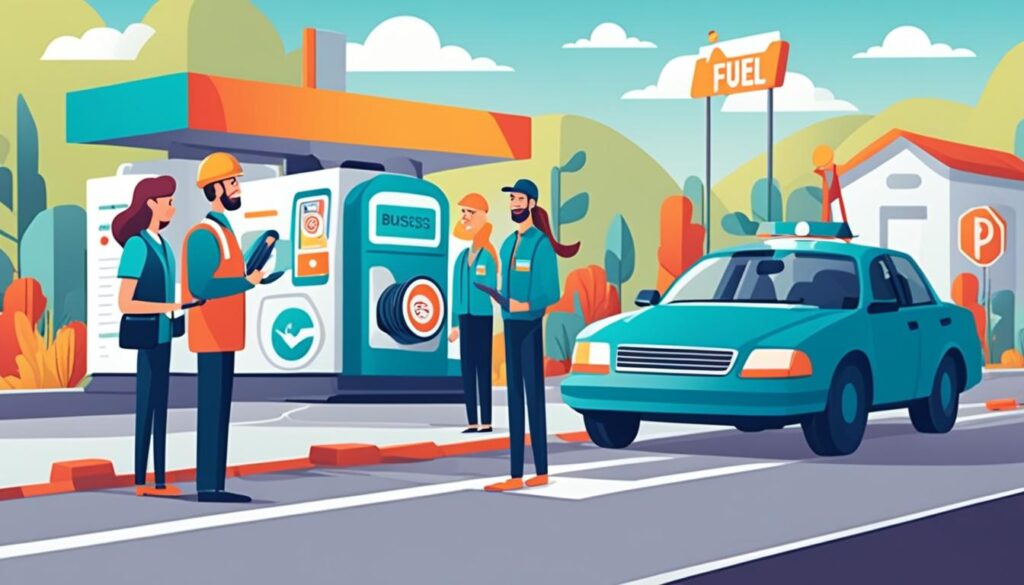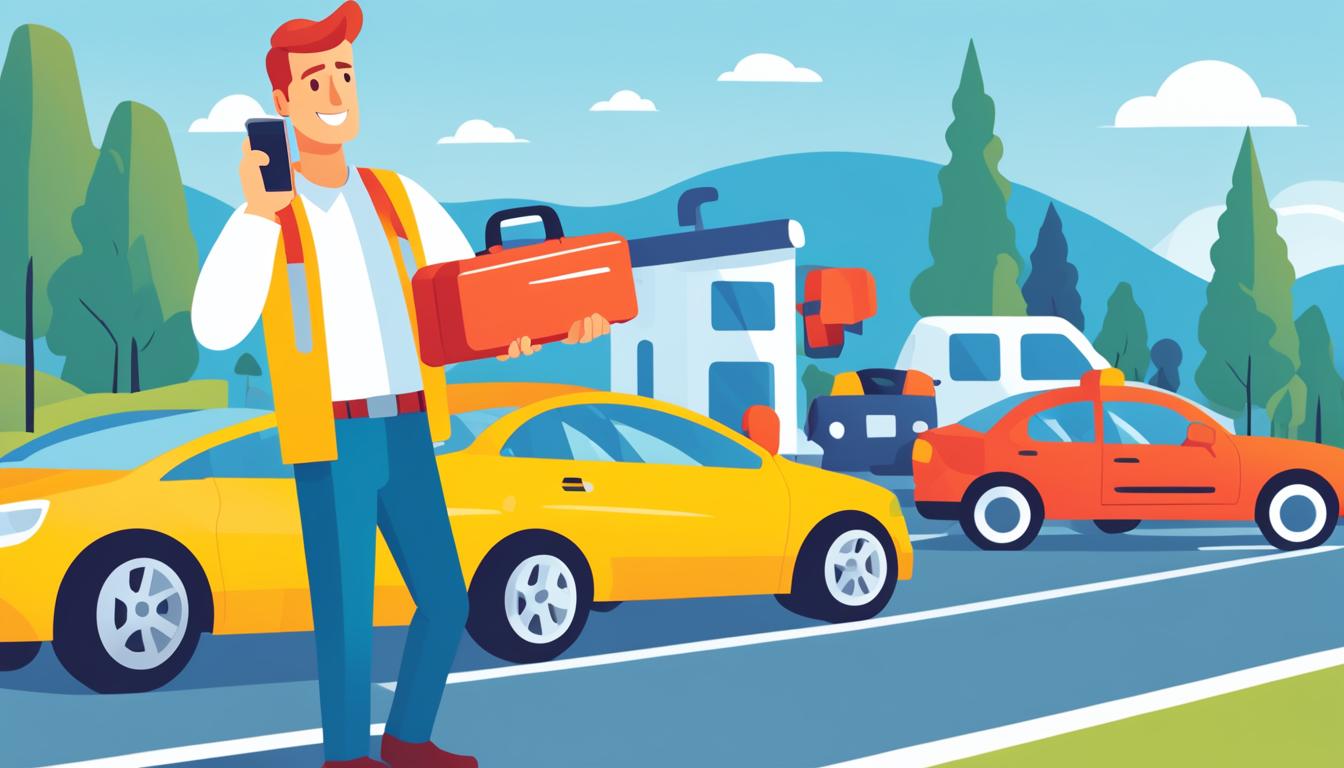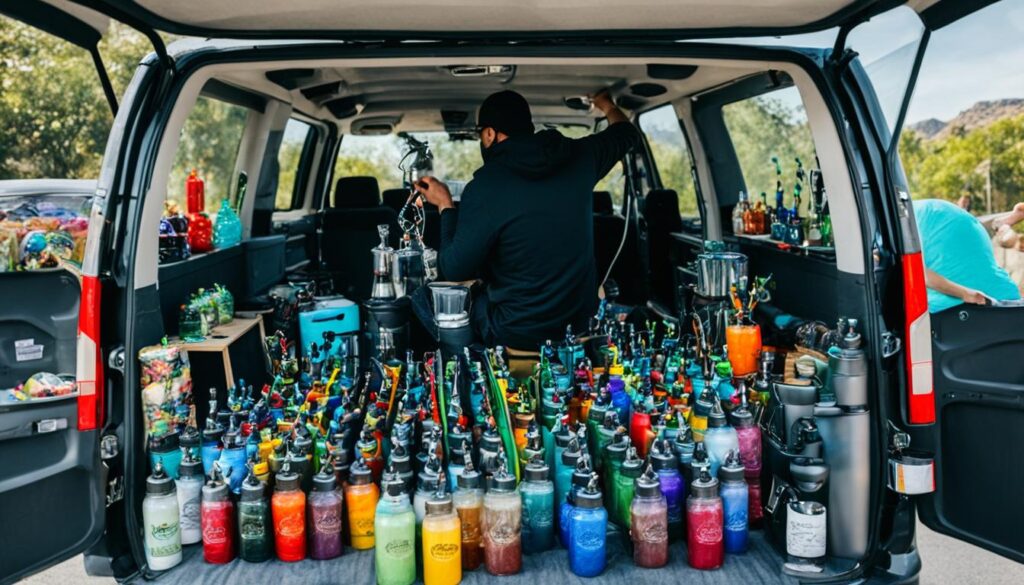The global vehicle roadside assistance market is set to reach a staggering $34.8 billion by 2030, and with over 285 million vehicles on U.S. roads, the demand for reliable roadside services has never been higher. Starting a roadside assistance business without towing presents a unique opportunity for entrepreneurs to tap into this booming industry while keeping operating costs and capital investment to a minimum.
By focusing on essential services like mobile mechanics, battery services, lockout assistance, flat tire assistance, fuel delivery, winching services, minor repairs, and providing emergency supplies, you can carve out a profitable niche in the crowded roadside assistance market. The average national income for a contracted roadside assistance provider is $44,553 per year, with the majority of salaries falling between $27,500 and $47,000 annually, making this venture an attractive prospect for motivated entrepreneurs.
Key Takeaways
- The global roadside assistance market is projected to reach $34.8 billion by 2030
- There are over 285 million vehicles on U.S. roads, driving high demand for roadside services
- Starting a roadside assistance business without towing minimizes operating costs and capital investment
- Focus on essential services like mobile mechanics, battery services, and lockout assistance to create a unique niche
- The average annual income for contracted roadside assistance providers ranges from $27,500 to $47,000
Understanding the Roadside Assistance Industry
As you embark on your journey to start a roadside assistance business without towing, it’s crucial to gain a deep understanding of the industry landscape. The roadside assistance sector is a dynamic and ever-evolving field that presents a wealth of opportunities for entrepreneurs like you. By familiarizing yourself with the types of services offered, market demand, and growth potential, you can position your business for success in this thriving industry.
Types of Services Offered
Roadside assistance businesses offer a wide range of services to help stranded motorists get back on the road safely. Some of the most common services include:
- Battery jump-starts and replacements
- Flat tire changes and repairs
- Fuel delivery
- Lockout assistance
- Minor mechanical repairs
By focusing on these non-towing services, you can differentiate your business and cater to the specific needs of your target market.
Market Demand and Potential
The demand for roadside assistance services is consistently high, with hundreds of thousands of calls for help made each day in the United States. This trend is only expected to grow as more people rely on their vehicles for daily transportation. Consider these factors:
- Over 97% of the population owns a smartphone, making it easier than ever to request roadside assistance
- The increasing complexity of modern vehicles leads to more frequent breakdowns and need for professional help
- Busy lifestyles and longer commutes contribute to a higher likelihood of roadside emergencies
As you can see, the market potential for a roadside assistance business without towing is immense. By staying attuned to industry trends and adapting your services to meet the evolving needs of customers, you can capitalize on this growth potential and build a thriving business in the years to come.
Identifying Your Niche
When starting a roadside assistance business without towing, it’s crucial to identify your niche and target specific customer segments. By specializing in non-towing services, you can differentiate your business from competitors and attract customers who require specific assistance.

Specializing in Non-Towing Services
Consider offering a range of services that cater to the needs of stranded motorists without involving towing. Some popular non-towing services include:
- Battery replacement and jump-starting
- Tire change and repair services
- Lockout assistance for customers who have locked their keys inside the vehicle
- Fuel delivery for vehicles that have run out of gas
- Mobile mechanic services for minor repairs and diagnostics
By focusing on these niche services, you can establish your business as a go-to provider for specific roadside assistance needs.
Targeting Specific Customer Segments
Identify the customer segments that are most likely to require your non-towing services. Some potential target markets include:
- Commuters who frequently travel long distances and may encounter battery or tire issues
- Elderly individuals who may require assistance with lockouts or minor mechanical problems
- College students who may not have access to towing services or prefer cost-effective solutions
- Fleet managers who need reliable roadside assistance for their vehicles without the added expense of towing
By understanding your target market and their specific needs, you can tailor your services and marketing efforts to effectively reach and serve these customer segments.
Developing Your Business Plan
When starting a roadside assistance business without towing, crafting a comprehensive business plan is essential. This plan will serve as the foundation for your venture, guiding your daily operations and influencing your revenue streams. A well-structured business plan will help you accurately determine your startup costs and initial capital requirements.
To begin, consider the various expenses you’ll incur when launching your business. These startup costs typically include:
- License and insurance premiums
- Equipment purchases
- Office space rental
- Employee salaries
By eliminating towing services from your offerings, you can significantly reduce your overall operating costs. This decision allows you to bypass expenses related to towing equipment, vehicles, associated insurance, maintenance, and repairs. Instead, focus on providing non-towing services such as battery and tire services, fuel delivery, car lockout services, and quick mechanical repairs.
As you develop your pricing strategy, consider implementing a subscription model where customers pay a monthly or annual fee for specific roadside services. This approach can generate a steady income stream for your tow-free roadside assistance business. Additionally, leveraging partnerships with towing companies for referrals can provide additional revenue streams and broaden the scope of services you offer.
Don’t forget to allocate a portion of your budget for contingency funds. These funds will help you navigate unexpected expenses or challenges that may arise during the early stages of your business. By planning for the unexpected, you’ll be better prepared to weather any storms and keep your roadside assistance business on track.
Obtaining Necessary Licenses and Permits
Before launching your roadside assistance business without towing, it’s crucial to ensure that you have all the necessary licenses and permits in place. Navigating the legal requirements can seem daunting, but with the right guidance, you can streamline the process and get your business up and running smoothly. In this section, we’ll walk you through the essential steps of registering your business and meeting the legal obligations specific to the roadside assistance industry.
Registering Your Business
The first step in starting your roadside assistance business is to register it with your local and state governments. This process typically involves choosing a business structure, such as a sole proprietorship, partnership, or limited liability company (LLC), and obtaining an Employer Identification Number (EIN) from the Internal Revenue Service (IRS). To simplify the registration process, consider using online resources like LegalZoom or consulting with a local accountant who specializes in small business formation.
Meeting Legal Requirements
Once your business is registered, you’ll need to obtain the necessary licenses and permits specific to the roadside assistance industry. These requirements may vary depending on your location and the services you plan to offer. Some common licenses and permits include:
- Business license
- Occupational license
- Mobile repair service license
- Resale permit (if you plan to sell parts or supplies)
In addition to these licenses and permits, it’s essential to secure proper insurance coverage for your roadside assistance business. This may include general liability insurance, professional liability insurance, and workers’ compensation insurance if you plan to hire employees. Consult with a reputable insurance provider who understands the unique needs of the roadside assistance industry to ensure that you have adequate coverage.
By taking the time to register your business and obtain the necessary licenses, permits, and insurance, you’ll lay a solid foundation for your roadside assistance business without towing. This proactive approach will not only help you avoid legal issues down the road but also demonstrate your commitment to operating a professional and compliant business.
Acquiring Essential Equipment and Tools
When starting your roadside assistance business without towing, it’s crucial to invest in the right equipment and tools to deliver top-notch services to your customers. The number of tools you need depends on the specific services you plan to offer. Licensing and business registrations could cost you between $200 and $350, while equipment expenses can range from $1,500 to $5,000, not including service vehicles. Business insurance costs vary, but you should budget for at least $100 on the low end and $400 or more on the high end.
Diagnostic Tools
To provide efficient and accurate services, you’ll need a set of reliable diagnostic tools. These tools help you quickly identify issues with vehicles and determine the best course of action. Some essential diagnostic tools for your roadside assistance business include:
- OBD-II scanner
- Digital multimeter
- Compression tester
- Vacuum gauge
- Leak detector
Battery and Tire Replacement Equipment
Battery and tire services are among the most common requests in the roadside assistance industry. To handle these calls effectively, you’ll need the following equipment:
- Jump starter or booster pack
- Battery tester
- Tire inflator
- Tire pressure gauge
- Tire plug kit
- Spare tire and jack
Lockout Kits and Fuel Delivery Containers
Lockout services and fuel delivery are also popular among stranded motorists. To provide these services, you’ll need:
- Lockout kit with long reach tools
- Wedges and air wedge
- Fuel can or container
- Siphon pump
Investing in high-quality equipment is essential for providing reliable services and building a strong reputation in the roadside assistance industry. As you grow your business and expand your service offerings, you may need to acquire additional tools and equipment to meet the needs of your customers.
Establishing Partnerships and Contracts
As you embark on your journey to start a roadside assistance business without towing, forging strategic partnerships and securing contracts can significantly boost your success. By collaborating with established towing companies and insurance providers, you can expand your service offerings and tap into a wider customer base, even if you don’t directly provide towing services.

Collaborating with Towing Companies
Partnering with reputable towing companies in your area can be a game-changer for your roadside assistance business. By establishing referral agreements, you can earn commissions for sending customers their way when towing services are required. This arrangement allows you to offer a more comprehensive service to your clients while focusing on your core non-towing services. To find potential towing company collaborations, consider the following steps:
- Research local towing companies with a strong reputation and reliable service
- Reach out to them and propose a mutually beneficial referral partnership
- Negotiate fair referral commissions that make sense for both parties
- Establish clear communication channels and protocols for seamless referrals
Securing Contracts with Insurance Providers
Another crucial aspect of starting a successful roadside assistance business without towing is securing contracts with insurance providers. Many car insurance companies offer roadside assistance coverage to their policyholders, and they often outsource these services to third-party providers like your business. By becoming an approved vendor for insurance provider contracts, you can tap into a steady stream of customers and revenue. Here’s how you can approach this:
- Identify the major insurance providers in your area that offer roadside assistance coverage
- Contact their vendor management departments and inquire about becoming an approved service provider
- Provide all necessary documentation, including proof of insurance, licenses, and certifications
- Negotiate competitive rates and service level agreements to ensure a fair and profitable partnership
By leveraging partnerships with towing companies and insurance providers, you can significantly enhance the scope and profitability of your roadside assistance business, even without directly offering towing services. To learn more about how to start a roadside assistance business without towing and maximize your success, visit Roadside Genius for expert guidance and resources.
Building Your Team
When starting a roadside assistance business without towing, building a strong and skilled team is crucial for success. With over 557 positions in the industry that can be filled without towing services, there are ample opportunities to hire technicians and staff members who specialize in non-towing services.
Hiring Skilled Technicians
To ensure that your roadside assistance business delivers top-notch service, it’s essential to hire skilled technicians who are proficient in various non-towing services. When recruiting technicians, look for individuals with experience in:
- Diagnostic checks
- Battery replacements
- Tire services
- Vehicle jump-starts
- Basic mechanical repairs
By hiring technicians with expertise in these areas, your business can establish itself as a go-to service provider for stranded drivers, even without offering towing services.
Training Staff in Customer Service
In addition to technical skills, it’s crucial to train your staff in customer service. The majority of your customers will likely be frustrated drivers experiencing car troubles, so your team must be equipped with the necessary skills to handle these situations effectively and professionally. Focus on developing the following skills during your staff training program:
- Patience
- Empathy
- Excellent communication
- Problem-solving
- Professionalism
By investing in staff training, you can ensure that your team is well-prepared to deliver exceptional customer service, which is a key factor in building a successful roadside assistance business without towing.
Implementing Effective Marketing Strategies
To succeed in the competitive roadside assistance industry, you need a strong marketing plan that leverages both digital and traditional channels. In today’s digital age, having a strong online presence is crucial for attracting customers and building your brand.
Start by
Building a Professional Website
that showcases your services, contact information, and glowing customer reviews. Your website serves as your digital storefront and should convey expertise and reliability. Next, focus on
Leveraging Social Media Platforms
like Facebook, Instagram, and LinkedIn to engage with your target audience, share helpful content, and cultivate a loyal following. Implement SEO best practices to improve your website’s search engine rankings and drive organic traffic from people searching for roadside assistance in your area.
While digital marketing is essential, don’t overlook the power of
Utilizing Local Advertising Channels
to reach potential customers. Consider running targeted ads on local radio stations, distributing flyers in high-traffic areas, and even investing in billboard space along busy roadways. By combining online and offline tactics, you’ll be well-positioned to spread the word about your roadside assistance business and attract a steady stream of customers in need of your services.
FAQ
What services can I offer in a roadside assistance business without towing?
Is there a high demand for roadside assistance services?
How can I differentiate my roadside assistance business without towing?
What should I include in my business plan for a roadside assistance company?
What licenses and permits do I need to start a roadside assistance business?
What equipment and tools are essential for a roadside assistance business without towing?
How can partnerships benefit my roadside assistance business?
What should I look for when hiring technicians for my roadside assistance business?
How can I market my roadside assistance business effectively?
Author
-

Lucas Martinez is an accomplished entrepreneur with a passion for startups. He has launched and scaled multiple businesses, providing pragmatic advice on starting and growing a business.
View all posts



